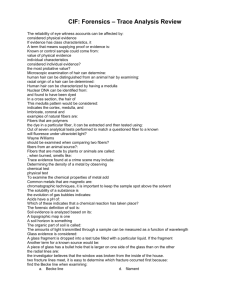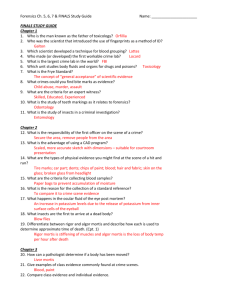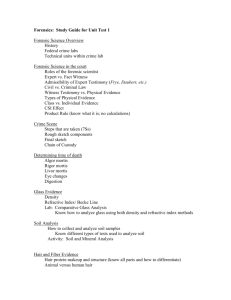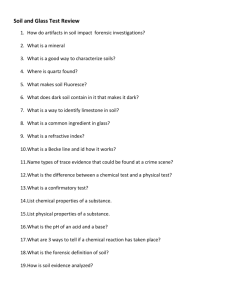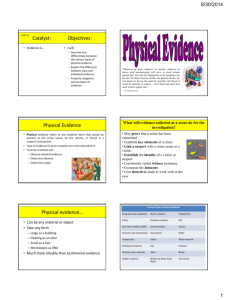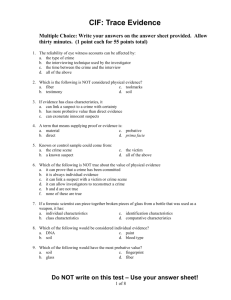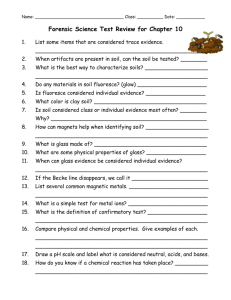Types of Evidence - Henry County Schools
advertisement
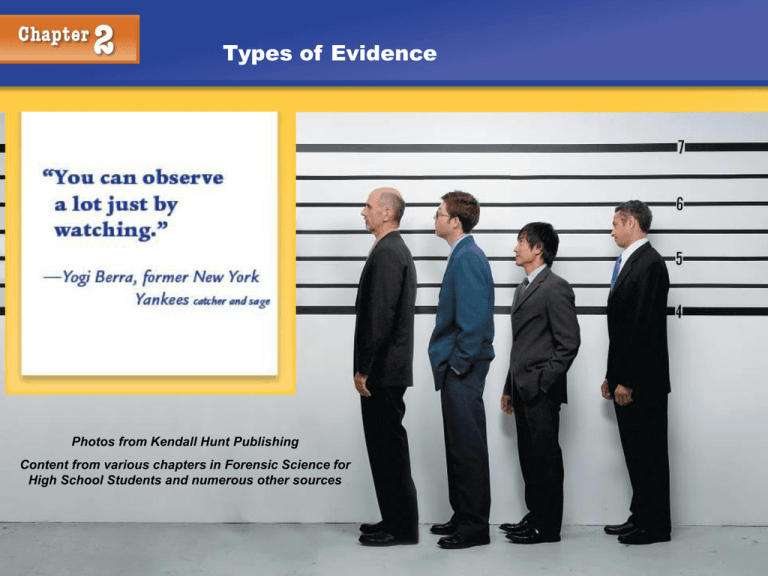
Types of Evidence Photos from Kendall Hunt Publishing Content from various chapters in Forensic Science for High School Students and numerous other sources Types of Evidence Classification of Evidence Testimonial evidence is a statement made under oath; also known as direct evidence or prima facie evidence. Physical evidence is any object or material that is relevant in a crime; also known as indirect evidence. Examples are hair, fiber, fingerprints, documents, blood, soil, drugs, toolmarks, impressions, glass. 2 Types of Evidence Reliability of Eyewitness Factors that affect accuracy: Nature of the offense and the situation in which the crime is observed Characteristics of the witness Manner in which the information is retrieved Additional factors: Witness’s prior relationship with the accused Length of time between the offense and the identification Any prior identification or failure to identify the defendant Any prior identification of a person other than the defendant by the eyewitness 3 Types of Evidence Eyewitness A police composite may be developed from the witness testimony by a computer program or forensic artist. FACES—a composite program by InterQuest 4 Types of Evidence Physical Evidence As a result of the influences on eyewitness memory, physical evidence becomes critical. Is generally more reliable than testimonial evidence Can prove that a crime has been committed Can corroborate or refute testimony Can link a suspect with a victim or with a crime scene Can establish the identity of persons associated with a crime Can allow reconstruction of events of a crime 5 Types of Evidence Reconstruction Physical evidence can be used to answer questions about: What took place at a crime scene The number of people involved The sequence of events A forensic scientist compares the questioned or unknown sample from the crime scene with a sample of known origin. 6 Types of Evidence Types of Physical Evidence Transient evidence is temporary; easily changed or lost; usually observed by the first officer at the scene. Pattern evidence is produced by direct contact between a person and an object or between two objects. Conditional evidence is produced by a specific event or action; important in crime scene reconstruction and in determining the set of circumstances or sequence within a particular event. Transfer evidence is produced by contact between person(s) and object(s), or between person(s) and person(s). Associative evidence is something that may associate a victim or suspect with a scene or with each other; e.g., personal belongings. —Henry C. Lee and Jerry Labriola, Famous Crimes Revisited, 2001 7 Types of Evidence Examples of Transient Evidence Odor—putrefaction, perfume, gasoline, urine, burning, explosives, cigarette or cigar smoke Temperature—surroundings, car hood, coffee, water in a bathtub, cadaver Imprints and indentations— footprints, teeth marks in perishable foods, tire marks on certain surfaces 8 Types of Evidence Examples of Pattern Evidence Pattern evidence—mostly in the form of imprints, indentations, striations, markings, fractures, or deposits Blood spatter Clothing or article distribution Glass fracture Gunpowder residue Fire burn pattern Material damage Furniture position Body position Projectile trajectory Toolmarks Tire marks or skid marks Modus operandi 9 Types of Evidence Examples of Conditional Evidence Light—headlight, lighting conditions, lights on or off Smoke—color, direction of travel, density, odor Fire—color and direction of the flames, speed of spread, temperature and condition of fire Location—of injuries or wounds, of bloodstains, of the victim’s vehicle, of weapons or cartridge cases, of broken glass Vehicles—doors locked or unlocked, windows opened or closed, radio off or on, odometer mileage Body—position and types of wounds; rigor, livor, and algor mortis Scene—condition of furniture, doors and windows, any disturbance or signs of a struggle 10 Types of Evidence Classification of Evidence by Nature Biological—blood, semen, saliva, sweat, tears, hair, bone, tissues, urine, feces, animal material, insects, bacteria, fungi, botanical material Chemical—fibers, glass, soil, gunpowder, metals, minerals, narcotics, drugs, paper, ink, cosmetics, paint, plastic, lubricants, fertilizer Physical—fingerprints, footprints, shoeprints, handwriting, firearms, tire marks, toolmarks, typewriting Miscellaneous—laundry marks, voice analysis, polygraph, photography, stress evaluation, psycholinguistic analysis, vehicle identification 11 Types of Evidence Evidence Characteristics Individual—can be identified with a particular person or a single source •Fingerprints - 1 X 1060 • 1 in 1,000,000,000,000,000,000,000,000,000,000,000,000,000,000,000,000,000,000,000,000 Fingerprints Blood DNA Typing Class—common to a group of objects or persons 12 Types of Evidence Class vs. Individual Evidence These fibers are class evidence; there is no way to determine if they came from this garment. The large piece of glass fits exactly to the bottle; it is individual evidence. 13 Types of Evidence Class vs. Individual Evidence, continued Which examples do you think could be individual evidence? 14 Types of Evidence Forensic Investigations Include some or all of these seven major activities: 1. Recognition—the ability to distinguish important evidence from unrelated material Pattern recognition Physical property observation Information analysis Field testing 2. Preservation through the collection and proper packaging of evidence 15 Types of Evidence Forensic Investigations, continued 3. Identification using scientific testing Physical properties Chemical properties Morphological (structural) properties Biological properties Immunological properties 4. Comparison of class characteristics measured against those of known standards or controls; if all measurements are equal, then the two samples may be considered to have come from the same source or origin 16 Types of Evidence Forensic Investigations, continued 5. Individualization in demonstrating that the sample is unique, even among members of the same class 6. Interpretation—giving meaning to all the information 7. Reconstruction of the events in the case Inductive and deductive logic Statistical data Pattern analysis Results of laboratory analysis —Henry C. Lee and Jerry Labriola, Famous Crimes Revisited, 2001 17 Collecting Trace Evidence Who collects the evidence? Police Officer Crime Scene Investigator Forensic Scientist Depends on the state/community Often one person to ensure consistency of labeling 18 Trace > Collecting Collect trace or entire object? Suppose a glove appears to have glass, fibers and blood on it. Should the glass, fibers and blood be removed and packaged separately? Should the entire glove be packaged? 19 Trace > Collection Considerations before packaging entire object: Object may be too large or difficult to move Trace evidence may fall off item during transport. Trace Evidence may be transferred to different, irrelevant area of object. If packaging object, package objects separately. Prevents trace being transferred to other objects. 20 Trace > Collection These 3 methods can be done at the crime scene or in the crime lab. 1. Visual Inspection 2. Tape Lift 3. Vacuum 21 Trace > Collection Visible Inspection Use naked eye or hand lens. Evidence removed and packaged for later analysis Use bright light and forceps to collect. 22 Trace > Collection Visible Inspection (Packaging) Small paper envelopes are bad (Holes allow small objects to escape). Use small plastic bags, glass vial or paper using a druggist fold. Double package. Label each package. 23 Trace > Collection Tape Lift Clear tape is used. Repeatedly apply tape to small area until most of the stickiness is gone. Tape is folded back upon itself, taped to a glass slide or taped to a piece of plastic. Put in separate labeled container. Be sure to document specific area covered. 24 Trace > Collection Vacuuming Nozzle should be short and transparent. Debris is collected on a filter or membrane 25 Trace > Collection Vacuuming Small area is vacuumed. (Filters changed frequently) Filters packaged in separate labeled container. (Be sure to document specific area covered) Most improperly used method because it often results in the collection of a lot of irrelevant material. 26 Druggist Fold Consists of folding one end of the paper over one third, then folding the other end one third over that, and repeating the process from the other two sides. After the paper is folded in this manner, the outside two edges are tucked into each other to produce a closed container that keeps specimen from falling out. 27 Types of Evidence Wayne Williams Trial • Fulton County Case in 1981 • First case in which primary evidence was fiber evidence • Fibers linked Williams to being in contact with the bodies • Media released info that GBI/FBI were collecting fibers • Williams began dumping nude bodies in rivers 28 Types of Evidence Wayne Williams Trial • Fiber links to dog, cars, home, bedspread • He was convicted for being linked to the bodies prior to dumping • Set standard for murder trials based on overwhelming circumstantial evidence 29 Hair Hair 30 Hair Introduction Human hair is one of the most frequently found pieces of evidence at the scene of a violent crime. It can provide a link between the criminal and the crime. From hair, one can determine: If the source is human or animal Race (sometimes) Origin of the location on the source’s body Whether the hair was forcibly removed If the hair has been treated with chemicals If drugs have been ingested 31 Hair Skin Structure 32 Hair Hair Shaft Composed of: Cuticle—outside covering, made of overlapping scales Cortex—inner layer made of keratin and embedded with pigment; also contains air sacs called cortical fusi Medulla—inside layer running down the center of the cortex 33 Hair The Cuticle The cuticle is the outermost layer of hair which is covered with scales. The scales point toward the tip of the hair. Scales differ among species of animals and are named based on their appearance. The three basic patterns are: Coronal Spinous Imbricate 34 Hair Human Scales In order to visualize the scales: Paint clear fingernail polish on a glass slide. When the polish begins to dry, place a hair on the polish. When it is almost dry, lift off the hair and observe the scale imprints. What pattern is seen in this slide? 35 Hair The Cortex The cortex gives the hair its shape. It has two major characteristics: Melanin—pigment granules that give hair its color Cortical fusi—air spaces, usually found near the root but may be found throughout the hair shaft 36 Hair The Medulla The medulla is the hair core that is not always visible. The medulla comes in different types and patterns. Types: Intermittent or interrupted Fragmented Continuous Stacked Absent—not present 37 Hair Human Medulla Human medulla may be continuous, fragmented, or absent. 38 Hair Medullary Index Determined by measuring the diameter of the medulla and dividing it by the diameter of the hair. mouse Medullary index for human hair is generally less than 1/3. For animal hair, it is usually greater than 1/2. 39 Hair Hair Shape Can be straight, curly, or kinky, depending on the cross-section, which may be round, oval, or crescent-shaped. Round (Straight) Oval (Curly) Crescent moon (Kinky) 40 Hair Hair Growth Terminology Anagen—hair is actively growing; lasts up to 5 years Catagen—hair is not growing; a resting phase Telogen—follicle is getting ready to push the hair out; lasts two to six months Grows about 0.4 mm per day, or 1 cm per month; approximately onehalf inch per month 41 Hair The Root Human roots look different based on whether they have been forcibly removed or they are telogen hairs and have fallen out. Animal roots vary, but in general have a spear shape. Fallen out Forcibly removed 42 Hair Hair Comparison Color Scale types Length Presence or absence of medulla Diameter Distribution, shape, and color intensity of pigment granules • Dyed hair has color in cuticle and cortex Medullary type Medullary pattern Medullary index • Bleaching removes pigment and gives a yellow tint 43 Hair DNA from Hair The root contains nuclear DNA. If the hair has been forcibly removed, some follicular tissue containing DNA may be attached. The hair shaft contains abundant mitochondrial DNA, inherited only from the mother. It can be typed by comparing relatives if no DNA from the body is available. This process is more difficult and more costly than using nuclear DNA. 44 Hair Collection of Hair Questioned hairs must be accompanied by an adequate number of control samples. • From victim • From possible suspects • From others who may have deposited hair at the scene Control sample • 50 full-length hairs from all areas of scalp • 24 full-length pubic hairs 45 Hair Hair Toxicology Advantages: • Easy to collect and store • Is externally available • Can provide information on the individual’s history of drug use or evidence of poisoning Collections must be taken from different locations on the body to get an accurate timeline. 46 Hair Hair Toxicology, continued Napoleon died in exile in 1821. By analyzing his hair, some investigators suggest he was poisoned by the deliberate administration of arsenic; others suggest that it was vapors from the dyes in the wallpaper that killed him. 47 Hair More about Hair For additional information about hair and other trace evidence, check out truTV’s Crime Library at: www.crimelibrary.com/criminal_mind/forensics/trace/1.html 48 Fibers Fibers Fibers Are considered class evidence Have probative value Are common trace evidence at a crime scene Can be characterized based on comparison of both physical and chemical properties Kendall/Hunt Publishing Company 5050 Fibers Fabric Fabric is made of fibers. Fibers are made of twisted filaments. Types of fibers and fabric: Natural—animal, vegetable, inorganic Artificial—synthesized or created from altered natural sources or Kendall/Hunt Publishing Company 5151 Fibers Types of Fibers Synthetic Natural Rayon Silk Nylon Cotton Acetate Wool Acrylic Mohair Spandex Cashmere Polyester Kendall/Hunt Publishing Company 5252 Fibers Classification Natural fibers are classified according to their origin: Vegetable or cellulose Animal or protein Mineral Kendall/Hunt Publishing Company 5353 Fibers Cellulose Fibers Cotton—vegetable fiber; strong, tough, flexible, moistureabsorbent, not shape-retentive Rayon—chemically altered cellulose; soft, lustrous, versatile Cellulose acetate—cellulose that is chemically altered to create an entirely new compound not found in nature Kendall/Hunt Publishing Company 5454 Fibers Fiber Comparison Can you describe the difference(s) between the cotton on the left and the rayon on the right? Kendall/Hunt Publishing Company 5555 Fibers Protein Fibers Wool—animal fiber coming most often from sheep, but may be goat (mohair), rabbit (angora), camel, alpaca, llama, or vicuña Silk—insect fiber that is spun by a silkworm to make its cocoon; the fiber reflects light and has insulating properties Kendall/Hunt Publishing Company 5656 Fibers Mineral Fibers Asbestos—a natural fiber that has been used in fire-resistant substances Rock wool—a manufactured mineral fiber Fiberglass—a manufactured inorganic fiber Kendall/Hunt Publishing Company 5757 Fibers Synthetic Fibers Made from derivatives of petroleum, coal, and natural gas Nylon—most durable of man-made fibers; extremely lightweight Polyester—most widely used man-made fiber Acrylic—provides warmth from a lightweight, soft, and resilient fiber Spandex—extreme elastic properties Kendall/Hunt Publishing Company 5858 Fibers Fabric Production Fabrics are composed of individual threads or yarns that are made of fibers and are knitted, woven, bonded, crocheted, felted, knotted, or laminated. Most are either woven or knitted. The degree of stretch, absorbency, water repellence, softness, and durability are all individual qualities of the different fabrics. Kendall/Hunt Publishing Company 5959 Fibers Weave Terminology Yarn—a continuous strand of fibers or filaments that may be twisted together Warp—lengthwise yarn Weft—crosswise yarn Blend—a fabric made up of two or more different types of fibers Kendall/Hunt Publishing Company 6060 Fibers Weave Patterns Kendall/Hunt Publishing Company 6161 Fibers Plain Weave The simplest and most common weave pattern The warp and weft yarns pass under each other alternately Design resembles a checkerboard Kendall/Hunt Publishing Company 6262 Fibers Twill Weave The warp yarn is passed over one to three weft yarns before going under one. Makes a diagonal weave pattern. Design resembles stair steps. Denim is one of the most common examples. Kendall/Hunt Publishing Company 6363 Fibers Satin Weave The yarn interlacing is not uniform Creates long floats Interlacing weave passes over four or more yarns Satin is the most obvious example Kendall/Hunt Publishing Company 6464 Fibers Knitted Fabric Knitted fabrics are made by interlocking loops into a specific arrangement. It may be one continuous thread or a combination. Either way, the yarn is formed into successive rows of loops and then drawn through another series of loops to make the fabric. Kendall/Hunt Publishing Company 6565 Fibers Polymers Synthetic fibers are made of polymers, which are long chains of repeating chemical units. The word polymer means many (poly) units (mer). The repeating units of a polymer are called monomers. By varying the chemical structure of the monomers or by varying the way they are joined together, polymers are created that have different properties. As a result of these differences, they can be distinguished from one another forensically. Kendall/Hunt Publishing Company 6666 Fibers Filament Cross Sections Round 4-lobed Octalobal Trilobal Irregular Dogbone or Dumbbell Multi-lobed or Serrate Synthetic fibers are forced out of a nozzle when they are hot, and then they are woven. The holes of the nozzle are not necessarily round; therefore, the fiber filament may have a unique shape in cross section. Kendall/Hunt Publishing Company 6767 Fibers Testing for Identification Microscopic observation Burning—observation of how a fiber burns, the odor, color of flame, color of smoke, and the appearance of the residue Thermal decomposition—gently heating to break down the fiber to the basic monomers Chemical tests—solubility and decomposition Kendall/Hunt Publishing Company 6868 Fibers Testing for Identification Density—the mass of an object divided by the volume of the object Refractive index—measurement of the bending of light as it passes from air into a solid or liquid Fluorescence—absorption and reemission of light; used for comparing fibers as well as spotting fibers for collection Kendall/Hunt Publishing Company 6969 Fibers Dyes Components that make up dyes can be separated and matched to an unknown. There are more than 7,000 different dye formulations. Chromatography is used to separate dyes for comparative analysis. The way a fabric accepts a particular dye may also be used to identify and compare samples. Kendall/Hunt Publishing Company 7070 Fibers Collection of Fiber Evidence Bag clothing items individually in paper bags. Make sure that different items are not placed on the same surface before being bagged. Make tape lifts of exposed skin areas and any inanimate objects. Removed fibers should be folded into a small sheet of paper and stored in a paper bag. Kendall/Hunt Publishing Company 7171 Fibers Fiber Evidence Fiber evidence in court cases can be used to connect the suspect to the victim or to the crime scene. In the case of Wayne Williams, fibers weighed heavily on the outcome of the case. Williams was convicted in 1982 based on carpet fibers that were found in his home, in his car, and on several murder victims. Kendall/Hunt Publishing Company 7272 Fibers More about Fibers For additional information about fibers and other trace evidence, check out truTV’s Crime Library at: www.crimelibrary.com/criminal_mind/forensics/trace/1.html Kendall/Hunt Publishing Company 7373 Trace Evidence 74 Trace Evidence Trace Evidence Trace evidence is physical evidence found in small amounts at a crime scene. Common examples would be hair, fiber, paint chips, body fluids, stains, powders, explosive residue, glass particles, vegetative matter, metal particles, and soil. It may also include more unusual types of evidence. 75 Trace Evidence Physical and Chemical Properties Physical property: A characteristic that does not involve a change in the identity of a substance, such as odor, color, boiling point, density, refractive index Chemical property: A characteristic that determines how a substance will change into another substance with different physical properties 76 Trace Evidence Metal Analysis Bits of metal can be identified from their physical and chemical properties. Solid particles—microscopic examination, magnetism, malleability, density, color, solubility, reactivity Dissolved metals—separation by chromatography with comparison of Rf values to known metals, specific reactions, and color tests 77 Trace Evidence Analysis of Metal Particles A Qualitative Analysis Approach 78 Trace Evidence Trace Evidence: Qualitative Analysis When investigators find substances at the scene of a crime and send them to the laboratory for identification, the forensic chemist uses several techniques or lab tests to identify them. One of these techniques is qualitative analysis. For example: A number of white powders that appear the same can be identified by their physical and chemical properties. 79 Trace Evidence Qualitative Analysis Microscopic Examination 80 Trace Evidence Qualitative Analysis, continued Check for: Solubility pH Chemical reactions • Color • Precipitate formation • Evolution of gas 81 Trace Evidence Flame Colors Many metal salts show a distinct color when heated. Sometimes this property can be used in an analysis. 82 Trace Evidence A Historical Crime In 1912, Emile Gourbin was a bank clerk in Lyons, France. He came under suspicion of strangling his girlfriend, Marie Latelle. Gourbin was arrested but had what appeared to be an airtight alibi. Edmond Locard went to Gourbin’s cell and removed scrapings from under his fingernails. The scrapings contained tissue that possibly came from Marie’s neck, but this was not provable. Locard noticed that the tissue was coated with a pink dust, which he identified as rice starch. On the particles he found bismuth, magnesium stearate, zinc oxide, and a reddish iron oxide pigment called Venetian red. Examination of the face powder used by Marie revealed that a powder prepared for her by a Lyons druggist was similar in composition. In these days of mass-produced face powder, this evidence would have far less significance. However, in 1912, because of the special preparation, it led to the confession of Gourbin. 83 Trace Evidence A More Recent Crime A bank robber was startled by an alarm just as the teller handed her the money. She grabbed it and, in her haste to get away, ran smack-dab into a glass door. Nevertheless, she recovered and got away. Subsequent examination of the door revealed a red lipstick imprint of the perpetrator’s mouth. Police later picked up a suspect, but needed evidence to link her to the robbery. Are lip prints unique enough to tie the suspect to the crime? http://www.hbo.com/autopsy/episode/episode_6_the_telltale_imprin t.html 84 Trace Evidence Lip Prints Lip prints are different and can be used to identify suspects. There are several general patterns: 85 Trace Evidence Chromatography of Lipsticks The lipstick used by the suspect could also have been compared to the residue on the door. Thin-layer chromatography (TLC) can be used to separate the components of a lipstick. The chromatograms can then be compared for a possible match. 86 Trace Evidence Paint Paint can be used as evidence in hitand-run cases. The layers of different paints in a cross section may be unique. 87 Soil and Glass Analysis Soil and Glass Analysis Objectives, continued You will be able to: Make density measurements on very small particles. Use logic to reconstruct events. Use technology and mathematics to improve investigations and communications. Identify questions and concepts that guide scientific investigations. 89 Soil and Glass Analysis Forensic Geology The legal application of earth and soil science Characterization of earthen materials that have been transferred between objects or locations and the analysis of possible origin or sources 90 Soil and Glass Analysis Forensic Geologist Tools Binocular microscopes Petrographic microscopes X-ray diffraction Scanning electron microscopes Microchemical analysis 91 Soil and Glass Analysis Forensic Geology History 1887–1893—Sir Arthur Conan Doyle wrote about scientific ideas and techniques for solving crimes in his writings of Sherlock Holmes. This included information about soil and its composition which had never actually been used. 1893—An Austrian criminal investigator, Hans Gross, wrote that there should be a study of “dust, dirt on shoes and spots on cloth.” He observed, “Dirt on shoes can often tell us more about where the wearer of those shoes had last been than toilsome inquiries.” 92 Soil and Glass Analysis Forensic Geology History, continued 1904—Georg Popp, a German forensic scientist, presented the first example of earth materials used as evidence in a criminal case, the strangulation of Eva Disch. 1910—Edmond Locard, a forensic geologist, was most interested in the fact that dust was transferred from the crime scene to the criminal. This helped to establish his principle of transfer. 93 Soil and Glass Analysis Soil A. Definition—naturally deposited materials that cover the earth’s surface and are capable of supporting plant growth B. The Earth • 75 percent—oceans, seas, and lakes • 15 percent—deserts, polar ice caps, and mountains • 10 percent—suitable for agriculture 94 Soil and Glass Analysis Soil, continued C. Formation • Living matter—plants, animals, microorganisms • Inorganic materials • Climate • Parent materials • Relief—slope and land form • Time 95 Soil and Glass Analysis Soil, continued D. Profile E. Composition • Topsoil • Sand • Subsoil • Silt • Parent material • Clay • Organic matter 96 Soil and Glass Analysis Soil, continued F. Nutrients—macro G. Nutrients—micro • Nitrogen • Manganese • Phosphorus • Iron • Potassium • Boron • Calcium • Copper • Magnesium • Zinc • Sulfur • Molybdenum • Chlorine 97 Soil and Glass Analysis Soil Comparisons May establish a relationship or link to the crime, the victim, or the suspect(s) Physical properties—density, magnetism, particle size, mineralogy Chemical properties—pH, trace elements 98 Soil and Glass Analysis Probative Value of Soil Types of earth material are virtually unlimited. They have a wide distribution and change over short distances. As a result, the statistical probability of a given sample having properties the same as another is very small. Evidential value of soil can be excellent. 99 Soil and Glass Analysis Increasing Probative Value Rare or unusual minerals Rocks Fossils Manufactured particles 10 0 Soil and Glass Analysis Minerals More than 2,000 have been identified. Twenty or so are commonly found in soils; most soil samples contain only three to five. Characteristics for identification—size, density, color, luster, fracture, streak, magnetism 10 1 Soil and Glass Analysis Rocks Aggregates of minerals Types • Natural—like granite • Man-made—like concrete Formation • Igneous • Sedimentary • Metamorphic 10 2 Soil and Glass Analysis Palynology The study of pollen and spores Important to know: What is produced in a given area The dispersal pattern Variation in size and weight For additional information about palynology, visit: http://science.uniserve.edu.au/faces/milne/milne.html 10 3 Soil and Glass Analysis Soil Evidence Class characteristics—the type of soil may have similar characteristics at the primary and/or secondary crime scene, on the suspect or on the victim Individual characteristics—only if the soil has an unusual or specialized ingredient such as pollen, seeds, vegetation, or fragments 10 4 Soil and Glass Analysis Sand Sand is the term applied to natural particles with a grain diameter between 1/16 mm and 2 mm. Its color and contents are dependent upon the parent rock and surrounding plant and animal life. (The photo on the right shows color differences in sand from six locations around the world.) 10 5 Soil and Glass Analysis Sand Characteristics Composition is based on the material of the source; also gives the sand its color Texture is determined by the way the source was transported • Shape • Grain size • Sorting 10 6 Soil and Glass Analysis Forensic Geology in the News A nine-year-old’s body was found in a wooded area along a river in Lincoln County, South Dakota. A forensic geologist collected soil samples from the fenders of a suspect’s truck and from the area where the body was found. Both soils contained grains of a blue mineral that turned out to be gahnite, a rare mineral that had never been reported in South Dakota. As a result, the soil tied the suspect to the crime. Check out other cases at: www.forensicgeology/science.htm 10 7 Soil and Glass Analysis Characteristics of Glass Hard, amorphous solid Usually transparent Primarily composed of silica, with various amounts of elemental oxides Brittle Exhibits conchoidal fracture 10 8 Soil and Glass Analysis Common Types Soda-lime—used in plate and window glass, glass containers, and electric lightbulbs Soda-lead—fine tableware and art objects Borosilicate—heat-resistant, like Pyrex Silica—used in chemical ware Tempered—used in side windows of cars Laminated—used in the windshield of most cars 10 9 Soil and Glass Analysis Physical Characteristics Density—mass divided by volume Refractive index (RI)—the measure of light bending due to a change in velocity when traveling from one medium to another Fractures Color Thickness Fluorescence Markings—striations, dimples, etc. 11 0 Soil and Glass Analysis Density Type of Glass Density window 2.46–2.49 headlight 2.47–2.63 Pyrex 2.23–2.36 lead glass 2.9–5.9 porcelain 2.3–2.5 11 1 Soil and Glass Analysis Determination of Refractive Index Immersion method—lower fragments into liquids whose refractive index is different Match point—when the refractive index of the glass is equal to that of the liquid Becke line—a halo-like glow that appears around an object immersed in a liquid. It disappears when the refractive index of the liquid matches the refractive index of the object (the match point). 11 2 Soil and Glass Analysis Determination of Refractive Index, continued The refractive index of a high-boiling liquid, usually a silicone oil, changes with temperature. This occurs in an apparatus called a hot stage which is attached to a microscope. Increasing the temperature allows the disappearance of the Becke line to be observed. At match point, temperature is noted and refractive index of the liquid is read from a calibration chart. 11 3 Soil and Glass Analysis The Becke Line The Becke line is a “halo” that can be seen on the inside of the glass on the left, indicating that the glass has a higher refractive index than the liquid medium. The Becke line as seen on the right is on the outside of the glass, indicating just the opposite. 11 4 Soil and Glass Analysis Refractive Index Liquid RI Glass RI Water 1.333 Vitreous silica 1.458 Olive oil 1.467 Headlight 1.47–1.49 Glycerin 1.473 Window 1.51–1.52 Castor oil 1.482 Bottle 1.51–1.52 Clove oil 1.543 Optical 1.52–1.53 Bromobenzene 1.560 Quartz 1.544–1.553 Bromoform 1.597 Lead 1.56–1.61 Cinnamon oil 1.619 Diamond 2.419 11 5 Soil and Glass Analysis Fracture Patterns Radial fracture lines radiate out from the origin of the impact; they begin on the opposite side of the force. Concentric fracture lines are circular lines around the point of impact; they begin on the same side as the force. 3R rule—Radial cracks form a right angle on the reverse side of the force. 11 6 Soil and Glass Analysis Sequencing A high-velocity projectile always leaves a wider hole at the exit side of the glass. Cracks terminate at intersections with others. This can be used to determine the order in which the fractures occurred. 11 7 Soil and Glass Analysis Glass as Evidence Class characteristics: physical and chemical properties such as refractive index, density, color, chemical composition Individual characteristics: if the fragments can fit together like pieces of a puzzle, the source can be considered unique 11 8 Soil and Glass Analysis Considerations for Collection The collector must consider that fragments within a questioned sample may have multiple origins. If possible, the collector should attempt an initial separation based on physical properties. The collector must consider the possibility that there may be a physical match to a known sample (e.g., a piece of glass to a fractured vehicle headlamp). When an attempt to make a physical match is made at the site of collection, the collector should take precautions to avoid mixing of the known and questioned samples. Any glass samples collected should be documented, marked (if necessary), packaged, and labeled. —Forensic Science Communications 11 9 Soil and Glass Analysis Collecting the Sample The glass sample should consist of the largest amount that can be practically collected from each broken object and packaged separately. The sample should be removed from the structure (e.g., window frame, light assembly). The inside and outside surfaces of the known sample should be labeled if a determination of direction of breakage or reconstruction of the pane is desired. When multiple broken glass sources are identified, it is necessary to sample all sources. A sample should be collected from various locations throughout the broken portion of the object in order to be as representative as possible. The sample should be collected with consideration being given to the presence of other types of evidence on that sample (e.g., fibers, blood). —Forensic Science Communications 12 0
